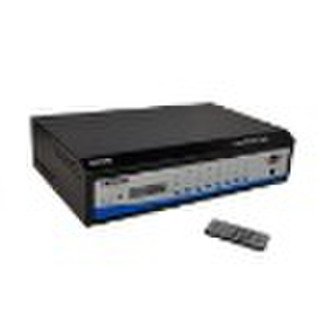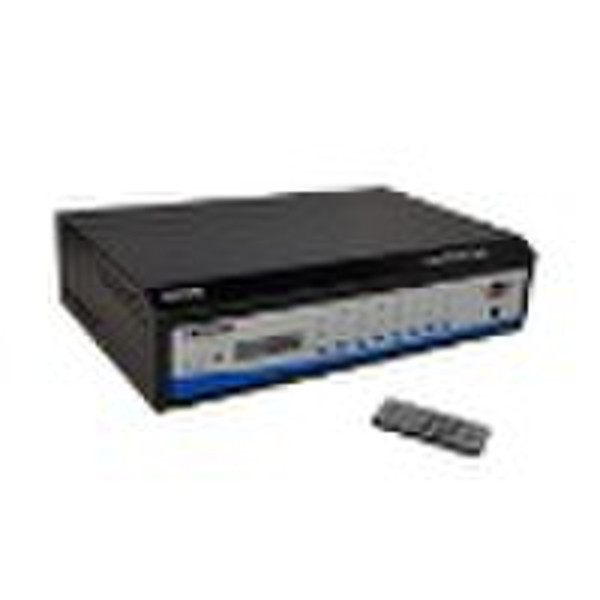Katalog
-
Katalog
- Auto & Motorrad
- Bauwesen und Immobilien
- Bekleidung
- Büro- und Schulartikel
- Chemikalien
- Dienstleistungen für Unternehmen
- Eisenwaren
- Elektrische Geräte & Zubehöre
- Elektronische Bauteile
- Energie
- Galanteriewaren
- Geschenke und Kunsthandwerke
- Gesundheit und Medizin
- Gummi und Kunststoffe
- Haus und Garten
- Haushaltsgeräte
- Koffer, Taschen & Hüllen
- Landwirtschaft
- Lebensmittel und Getränke
- Licht und Beleuchtung
- Maschinen, Geräte und Werkzeuge
- Maschinenteile und Herstellung Dienstleistungen
- Messapparat und Analysegerät
- Mineralien und Metallurgie
- Möbel
- Schuhe und Accessoires
- Schönheit und Körperpflege
- Service Geräte und -Ausstattung
- Sicherheit und Schutz
- Spielzeuge und Hobbys
- Sport und Unterhaltung
- Telekommunikations
- Textil und Lederware
- Transport
- Uhren, Schmuck, Brillen
- Umweltschutz
- Unterhaltungselektronik
- Verpacken und Drucken
- Werkzeuge
- Überschüssiger Warenbestand, Lager
Filters
Search

HDMI Matrix 8x8 Unterstützt 3D mit IR-Fernbedienung

Tony Maa
Kontaktperson
Basisdaten
| Ort der Herkunft | Zhejiang China (Mainland) |
|---|---|
| Marke | Signal |
| Modell-Nummer | HD08MT0808 |
| Geben | HDMI |
Key Features 1. Eight HDMI 1.3b input signals switched or split to eight HDMI 1.3b sink devices. 2. Each input can be controlled by IR remote, also can be switched by two buttons. 3.HDCP 1.2 protocol compliant. 4.Support CEC. 5.Support 3D display 6.Support deep color 30 bit, 36 bit. 7.Support Blue-Ray 24/50/60fs/HD-DVD/xvYCC. 8.Digital audio format, as DTS-HD/Dolby-TrueHD/LPCM7.1/DTS/Dolby-AC3/DSD. 9.Support signal retiming. 10.Support input up to 10-metre AWG24 HDMI 1.3 standard cable length,Output up to 20- metre AWG24 cable length. 11. It can smartly jump over those input sources which are not connected. 12. With RS-232 remote control, the software can be updated; Also the inputs can be switched or split to outputs with PC via RS-232. 13.With leds, the status of the inputs and outputs can be easily displayed. If and source or any sink if effectively connected, the relative led will be lit. 14. With seven-segment digital tube, the user can well know the relationship between the inputs and outputs. 15. With the smart function of memory, it can come back to the latest when Restarted or reconnected. 16.No loss of quality. 17.Installs in minutes. 18. Need DC24V/3A power supply. How to connect the HDMI Matrix to your devices 1.Connect one cable from each HDMI source devices into HDMI Matrix inputs. 2.Connect one cable from each display (monitor or projector) into the HDMI Matrix outputs. 3.Power on the matrix 4.Connect 24V power supply to the HDMI 8x8 Matrix. 5.Use the RMT-IR remote control port to remotely toggle between sources Specifications HDMI version....................................................HDMI 1.3b HDCP version....................................................HDCP1.2 HDMI resolution................................................24/50/60fs/1080p/1080i/720p/576p/576i/480p/480i Support video color format...............................24bit/deep color 30bit,36bit Support audio format.......................................DTS-HD/Dolby-trueHD/LPCM7.1/DTS/Dolby-AC3/DSD Audio output....................................................SPDIF and COAX Max transmission bandwidth...........................225MHz Max baud rate..................................................6.75Gbps Input/Output TMDS signal................................0.5 1.5Volts p-p Input/Output DDC signal.................................5Volts p-p (TTL) Input cable distance........................................≤15m AWG24 HDMI 1.3 standard cable Output cable distance......................................≤25m AWG24 HDMI 1.3 standard cable Max working current........................................2.2A Power adapter format.....................................Input:AC (50HZ, 60HZ) 100V-240V; Output: DC5V/3A Operating Temperature range........................(-15 to +55°C) Operating Humidity range...............................5 to 90%RH (No Condensation) Dimension (L x W x H).....................................400x250x95(mm)Weight............................................................1950g HDMI 4x2 Matrix HDMI 1x8 Splitter with IR remote control HDMI 1x4 Splitter with IR remote control HDMI 1x2 Splitter with IR remote control What is HDMI HDMI (High-Definition Multimedia Interface) is a compact audio/video interface for transmitting uncompressed digital data. It represents a digital alternative to consumer analog standards, such as radio frequency (RF) coaxial cable, composite video, S-Video, SCART, component video, Terminal, or VGA. HDMI connects digital audio/video sources—such as set-top boxes, upconvert DVD players, HD DVD players, Blu-ray Disc players,AVCHD camcorders, personal computers (PCs), video game consoles such as,the PlayStation 3, Xbox 360, and AV receivers—to compatible digital audio devices, computer monitors, and digital televisions.HDMI supports, on a single cable, any uncompressed TV or PC video format,including standard, enhanced, and high-definition video; up to 8 channels of compressed or uncompressed digital audio; and a Consumer Electronics Control (CEC) connection. The CEC allows HDMI devices to control each other when necessary and allows the user to operate multiple devices with one remote control handset. Because HDMI is electrically compatible with the signals used by Digital Visual Interface (DVI), no signal conversion is necessary, nor is there a loss of video quality when a DVI-to-HDMI adapter is used. As an uncompressed connection, HDMI is independent of the various digital television standards used by individual devices, such as ATSC and DVB, as these are encapsulations of compressed MPEG video streams (which can be decoded and output as an uncompressed video stream on HDMI). The HDMI standard was not designed to include passing closed caption data (for example, subtitles) to the television for decoding. So any closed caption stream has to be decoded and included as an image in the video stream(s) prior to transmission over an HDMI cable to be viewed on the DTV. This limits the caption style (even for digital captions) to only that decoded at the source prior to HDMI transmission. This also prevents closed captions when transmission overHDMI is required for up conversion. HDMI products started shipping in late 2003. Over 850 consumer electronics and PC companies have adopted the HDMI specification (HDMI Adopters). In Europe, either DVI-HDCP or HDMI is included in the HD ready in-store labeling specification for TV sets for HDTV, formulated by EICTA with SES Astra in 2005. HDMI began to appear on consumer HDTV camcorders and digital still cameras in 2006. Shipments of HDMI were expected to exceed that of DVI in 2008, driven primarily by the consumer electronics market.
Lieferbedingungen und Verpackung
Packaging Detail: color box or neutral packing Delivery Detail: 5-25 days after confirming the 30% deposit from buyer
Hafen: Shanghai or Ningbo
Zahlungsbedingungen
Letter of credit
Telegraphic transfer
-
Zahlungsarten
Wir akzeptieren:








